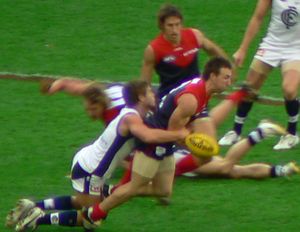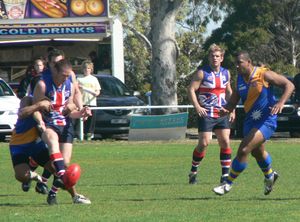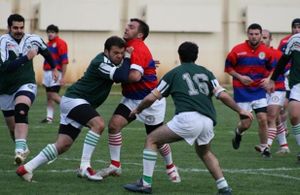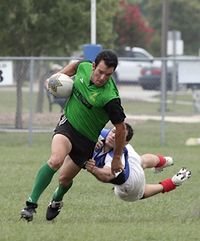Tackle (football move)

Most forms of football have a move known as a tackle. The primary purposes of tackling is to disposses an opponent of the ball, to stop the player from gaining ground towards goal or to stop them from carrying out what they intend.
The word is used in some contact variations of football to describe the act of physically holding or wrestling a player to the ground. In others, it simply describes one or more methods of contesting for possession of the ball. It can therefore be used as both a defensive or attacking move.
Contents |
Name origin
In Middle Dutch, the verb tacken meant to grab or to handle. By the 14th century, this had inspired a new use in sailing, referring to rigging, equipment, or gear used on ships. By the 18th century, a similar use was applied to harnesses or equipment used with horses. Modern use in football comes from the earlier sport of rugby, where the word was used in the 19th century.
Australian rules football

As there is no offside rule in Aussie Rules, players can be tackled from any direction, and often blindsided. For this reason, the sport allows shepherding methods for teammates to be able to protect the ball carrier.
The variety of different ways to contest possession in Aussie Rules has led to first time observers of the game regarding it as having "no rules" or as some Australian's unfamiliar with the game colloquially term it "Rafferty's Rules". Despite these stereotypes, however, there are actually quite strict rules governing tackling.
In Australian rules football, the move commonly described as a "tackle" is similar to in rugby and involves wrapping, holding or wrestling a player who has possession of the ball to the ground.
Tackling in Australian Rules is unique in that if tackled player does not dispose of the ball having had opportunity to do so (called the holding the ball rule), or concedes a penalty in the tackle (i.e. tries to throw the ball when he was only allowed to "handball" or kick it) the tackler is rewarded with a free kick. This is only paid if the player tackling does not either deliberately or unintentionally hold the ball to their opponents body.
A tackle must make contact below the shoulders and above the knees, and a player is able to be thrown to the ground, so long as the tackle is not reckless. There are also rules outlawing pushing in the back making tackling more difficult.
Players wear little to no padding to cushion the impact of tackles, however mouthguards are essential for keeping your teeth. As there is no offside rule in Aussie Rules, tackling is more often when chasing a player down rather than frequent on head on contact.
Types of Tackles in Aussie Rules
There are many types of tackles in Australian rules football:
- perfect tackle - when a player lays a tackle on an opponent that has had prior opportunity to dispose of the ball and in the process makes it impossible for their opponent to dispose of the ball. For example if a tackler pins an opponent's arm, then the opponent cannot possibly handball, and if they pin both arms, then it is nearly impossible to legally execute a kick. A player is almost always rewarded for a perfect tackle (except in the case of a slam tackle - see below).
- gang tackle - when the player in possession is tackled by more than one opponent at the same time.
- high tackle - any tackle which infringes on the opponent's neck or head. This includes any tackle which slips above the A/C joint. This is illegal and the penalty is a free kick.
- coathanger - slang for high contact to the head, usually by a stiff arm, which causes a player to land flat on their back. It is often accidental due to the high pace of the game. The penalty may be a free kick if deemed accidental or a reportable offence which may result in suspension.
- diving tackle - when a player leaves the ground in attempting to tackle
- slinging - a player slung to the ground in a tackle (although in the AFL these days, if a player loses possession of the ball while they are being thrown, the tackler will often get penalised for "holding the man".)
- broken tackle - when a player is able to break free of a tackle
- spear tackle - also known as a dangerous throw, it is a reportable offence and may result in suspension.
- push in the back - Any tackle which forces the player forward and/or into the ground from behind. This is an illegal tackle and the penalty is a free kick.
- bump or hip and shoulder tackle is a legal Aussie rules tactic for both dispossession of the player with the ball and also impeding players involved in a contest but not in possession of the ball. The difference between a bump and a tackle is that arms are not used in a bump, which must be made side-on using the hip and or shoulder. Not all bumping is legal, however. Aggressive head on bumping or "charging" of a player with the ball is often described as "rough play" and is a reportable offence, this is particularly so if a player is deemed to have their head down over the ball in an attempt to picking it up off the ground when the bump is applied or contact is made above the shoulders. Standing ground against an oncoming player, however, is legal.
- slam tackle - relatively new term for a tackle which results in an opponent's head being deliberately slammed to the ground. It is often associated with the pinning of the arms of an opponent so that they cannot cushion the impact of their head on the ground. Although tolerated in days gone by in recent years, in 2009, the AFL branded this a dangerous type of tackle. Incidents in the professional AFL involving Byron Pickett and Darren Milburn have come under particular scrutiny.[1]
- wing tackle or chicken wing tackle - when one arm is pinned in a tackle. After sustaining severe damage from this type of tackle during the 2009 AFL season, Brent Harvey called for this type of tackle to be banned.[2]
Great tacklers in the AFL are Brett Kirk, David Rodan, Jude Bolton, Rhan Hooper, James McDonald, Aaron Davey and Alwyn Davey.
Evasion skills
The player with possession of the ball can use evasion skills to avoid being tackled or caught holding the ball. These include:
Footwork
Techniques used before a tackle.
- baulk
- blind turn
- dummy - pretending to kick or handball, to confuse an opponent
- side step
- goose step
Current AFL players which have mastered these techniques and are rarely caught holding the ball are Robert Harvey and Chris Judd.
Breaking Skills
- Fend off or Don't argue - the player being tackled holds out their arm and uses their upper body strength to push off the tackler. Fending is not allowed to the head.
- chopping, using your arms to push away the outstretched arms of a tackler. Mostly used while running.
- shrug - pulling the arms and shoulders in, so that the tackler loses grip
- arch the back
- break - breaking a tackle, using their leg strength.
- spinning out of a tackle, sometimes called a pirouette
- turning the body - turning in a tackle to draw a free kick for a push in the back.
- duck the head - to either attempt to escape the tackle or to draw high contact and a free kick. This was once considered gutless and not rewarded by umpires who would call "play on", but in recent times with the AFL cracking down on high contact, the interpretation has become a grey area. More and more players are getting free kicks by deliberately attracting high contact to draw free kicks, which has led to a decrease in the willingness of players to lay tackles.
- Hold the ball above the head, or holding the ball in one hand. As tacklers cannot make high contact, the player with the ball can use their arms to release the ball by handball. Works best with taller players. Anthony Koutoufides was deadly in his use of this technique with his ability to hold the entire ball in one hand.
Current AFL players with great breaking skills include Gary Ablett, Jr., Daniel Kerr, Paul Chapman and Leon Davis.
Other methods
- Wearing lubricant on the arms, which can cause tacklers to slip off. Ben Cousins and many West Coast Eagles players do this for every game.
Other tackling methods
Although the term "ackle" is used in Australian Rules to exclusively describe wrapping, holding or wrestling a player in possession, there are also several other ways of contesting possession in Australian rules that other sports would describe as a "tackle" and that also involve a degree of contact.
Other defensive actions are generally categorised as one percenters. Colliding with other players whilst trying to catch or mark the ball is part of the game, however tackling a player jumping in the air to catch a ball is strictly not allowed. Bumping a player who is jumping to catch the ball is not allowed unless the player is deemed to have intentions to contest for possession or have "eyes for the ball". The defensive tactic of punching away (commonly known as spoiling) from a player is allowed. Smothering, which involves using the arms or body to get in the way of an opponent's kick as it leaves their boot, and is similar to a charge down in rugby football.
Gaelic football
Gaelic football defines tackling as wresting the ball from an opponent's hands. Bumping is allowed on the player with the ball, but a player cannot be grabbed.
American & Canadian football (gridiron football)

In American football and Canadian football, to tackle is to physically interfere with the forward progress of a player in possession of the ball, such that his forward progress ceases and is not resumed, or such that he is caused to touch some part of his body to the ground other than his feet or hands, or such that he is forced to go out of bounds. In any such case, the ball becomes dead, the down is over, and play ceases until the beginning of the next play. A tackle is known as a quarterback sack when the quarterback is tackled behind the line of scrimmage while attempting to throw a pass. A tackle for loss indicates a tackle that causes a loss of yardage for the opposing running back or wide receiver. A sack does not count as a tackle for loss. When a player who does not have the ball is taken down it is generally referred to as a block.
Tacklers are not required to wrap their arms around the ball carrier before bringing him to the ground; in fact, the ball carrier is often "tackled" by the defender taking a running start and hitting the ball carrier to knock them to the ground. Tackles can also be made by grabbing the ball carrier's jersey and pulling him to the ground. As mentioned above, the referee can declare that a play is dead if the ballcarrier's forward progress has been stopped, even if no actual "tackle" has occurred.
There are some restrictions on tackles and blocks. At no time may a defensive player tackle an offensive player by grabbing the facemask of a football helmet since doing so incurs a 15 yard penalty and the victimized team gets a new set of downs. A player may not use his helmet to tackle an opponent since the technique can cause serious injury to both players and also warrants a 15 yard penalty as well as a fresh set of downs. Grabbing a ball carrier by the pads behind his neck and pulling him down is known as a "horse collar," a method which has been made illegal at all levels of American football. It is also illegal to tackle a player who has thrown a forward pass (generally a quarterback) after he has released the ball, doing so is called "roughing the passer" and is a 15 yard penalty and a fresh set of downs. Place kickers and punters are also protected in a similar manner. Once the play is ruled over absolutely no contact is permitted, any player who makes contact with an opponent after the play is charged with "unnecessary roughness" and his team is assessed a fifteen yard penalty. Blocks that occur below the knees, initiated below the waist, or clotheslines are also prohibited and players who do them can expect far more severe penalties than other illegal tackles.
Tackle is also the name of player positions of interior linemen on both the offensive and defensive teams. Usually there is a left and right tackle on each team, though sometimes on defense there is only a single "nose tackle."
International rules football
International rules football is a hybrid game between Australian rules football and Gaelic football. Tackling in International Rules is subject to similar rules as Australian rules football, but with some subtle differences. Tackling is only allowed as low as the waist, whereas it is allowed down to the knees in Aussie Rules. One handed tackling has been banned in IR since the 2008 International Rules Series.
Rugby football
Rugby league

In rugby league the ball-carrier only may be tackled by any number of defenders from any direction. The initial contact in the tackle must be made below the ball carrier's neck or it will be deemed a high tackle and penalised. A tackle in rugby league is completed when any of the following occurs:
- The attacking player's ball-carrying arm comes into contact with the ground while still held by a defender.
- Although still on his feet, the attacking player's forward momentum has ceased while still held by a defender.
- The referee calls "Held".
Once the tackle is completed the ball-carrier must be allowed to get to his feet to 'play-the-ball'. Spear tackles are illegal in rugby league, with most tackles in which the defender is lifted 'above the horizontal' bringing about penalties in the modern game.
Rugby union

In rugby union, a player must be brought to ground for a tackle to be completed. The tackled player must release the ball, but the ball is not dead and a ruck forms to contest possession of it. If the ball carrier is not brought the ground a maul will usually form.
Association football
In association football, a player tackles an opponent by taking control of the ball from them. This is achieved by using either leg to wrest possession from the opponent, or sliding in on the grass to knock the ball away. The target of the tackle must always be the ball, otherwise it may be deemed as illegal by the referee, especially if the player makes contact with his opponent before the ball, or makes unfair contact with the player after playing the ball. If the tackle comes from the front or the side and succeeds in touching the ball first a player may still be penalised if the tackle endangers an opponent[3]. Tackling with both legs, or from behind is also illegal. This explicitly includes "scissoring" (tackling with legs apart, so as to trap the opponent's leg or legs in between), which is likely to be punished with a straight ejection (red card), as it poses a high risk of severe knee injury to the player being tackled. If a tackle is deemed legal, then play continues.
Tackling with studs up is considered dangerous, although it is not always punished.
Other uses
Other non-football games that feature tackling or similar concepts include British bulldogs and hurling, while hockey and shinty feature similar bumping or shoulder barging moves.
Allowable tackle types
| sliding tackle | spear tackle | dump tackle | body tackle | ankle tap | diving tackle | bumping/blocking | charge | steal/intercept ball | Chicken wing | other | |
|---|---|---|---|---|---|---|---|---|---|---|---|
| Association football[4] | Yes | No | No | No | No | No | No | No | Restricted[5] | No | |
| Australian rules football | No[6] | Reportable | Yes | Restricted[7] | No[8] | Yes | Yes[9] | Reportable | Yes | Yes | Spoil, Shepherd, Smother |
| Gaelic football[10] | No | No | No | No | No | No | Restricted[11] | No | No | Restricted[12] | |
| Gridiron football | Classified as a trip | Yes (except Quarterbacks) | Yes | Yes | Yes | Yes | Yes | Yes | Yes | Yes | |
| Rugby League | Yes | Reportable | Yes | Yes[13] | Yes | Yes | Penalty | Yes | Restricted[14] | Reportable | Charge down |
| Rugby union | Reportable | Reportable | Yes | Yes | Yes | Yes | Penalty | Yes | Restricted[15] | Penalty | Charge down |
Controversial techniques
- spear tackle (dangerous throw) - (illegal in both rugby codes & Australian rules)
- high tackle (illegal head-high tackle) - rugby league & Australian rules (see also coathanger)
- grapple tackle - a controversial rugby league tackling technique similar to a chokehold[1].
- chicken wing tackle - banned in rugby league
- horse-collar tackle - banned in gridiron football by the NFL, the NCAA, and the CFL. This technique involves reaching under shoulder pads and pulling them back, with the potential to cause severe injuries to the tackled player. It was made infamous by former Dallas Cowboys free safety Roy Williams (now with the Cincinnati Bengals) when he performed it on former Philadelphia Eagles wide receiver Terrell Owens (now with the Cincinnati Bengals).
References
- ↑ AFL not so tackle happy after Darren Milburn's tackle last season by Bruce Matthews. February 12, 2009
- ↑ http://www.news.com.au/heraldsun/sport/afl/story/0,26576,25402009-19742,00.html
- ↑ FIFA Laws of the Game
- ↑ Tackling with the hands strictly not allowed
- ↑ foot only
- ↑ Classified as a trip
- ↑ between knees and shoulders, no pushing in the back
- ↑ Classified as a trip
- ↑ within 5 metres of ball
- ↑ Tackling with the hands not allowed
- ↑ only on player with the ball
- ↑ no interference allowed
- ↑ No grappling around the neck
- ↑ no knock ons allowed
- ↑ no knock ons allowed
|
||||||||||||||||||||||||||||||||||||||||||||